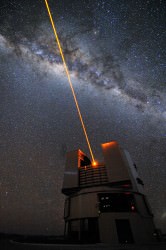In a previous video, I talked about the Fermi Paradox.
Our Universe is big, and it’s been around for a long time. So why don’t we see any evidence of aliens? If they are out there, why haven’t they contacted us, and how do we contact them? What methods might they use to try and contact us?
Where do we look for signs of alien civilizations?
The search for extraterrestrial intelligence, otherwise known as SETI, are the methods that scientists have proposed to discover evidence of aliens in the Universe.
Perhaps the most famous method is listening for their signals. Here on Earth, we have exploited the radio spectrum to send signals through the air. We even use it to communicate with spacecraft in the Solar System.
So, since it works so well for us, it makes sense that aliens might use radio waves to communicate from star to star. If there’s an alien civilization out there beaming a signal directly at the Sun, our largest radio telescopes should be able to pick up their signal.
The problem is that the galaxy is huge, with hundreds of billions of stars. Any one of which could be the world where the aliens live. Furthermore, we don’t know which frequency the aliens might use to communicate with us.
Even though the search for ET has been going for many years, we’ve only explored a fraction of the millions of available stars and frequencies on the radio spectrum.
So far, no definitive signal has been discovered.

Again, so far nothing has turned up.

Neutrinos are generated in high energy collisions, and can pass right through planets with ease. They would be incredibly difficult to detect with our current technology, but maybe advances in the future will make that a possible communication method.
But maybe Instead of searching for signals, we could look for their artifacts.
If the energy of transmitting signals across the vast reaches of space is too much, it might make more sense for aliens to construct self-replicating probes and let them journey from star to star.
These probes could leave behind an obvious alien-made structure which we could discover once we become a true spacefaring species.
We could also detect aliens by their impact on their home planets. With a large enough space telescope, we should be able to study the atmosphere of planets orbiting nearby stars. An industrialized civilization would probably be polluting its atmosphere with various gases — just like we have — which would be detectable.
Finally, we could search for evidence of aliens through their structures.
If a civilization starts building megastructures which block off a large portion of their star’s light, we should be able to detect evidence through our search for extrasolar planets.

There have been a few attempts to reach out to other worlds directly, transmitting signals out into space. It’s unlikely that these signals will actually reach any other civilization, and some scientists are concerned about the wisdom of this kind of communication.
Do we really want to alert potentially hostile aliens to our location in the Milky Way?
It’s exciting to think that there are other alien civilizations around us in the Milky Way, and with a little more work, we could discover their location and maybe even communicate with them.
Let’s hope they’re peaceful.


Dear Fraser
Thanks for adding script below all your videos on Universe Today. I am hearing impaired that this make your video’s accessible to me and many other perosns in the same position. Keep up the good work!!
Thanks for adding script below your video’s on Universe Today. I am hearing disabled and this makes the videos accessible to me and many other persons in the same position.
Great points, though I wish you’d have gone deeper into why traditional radio-based SETI is not working.. Most people don’t realize the sad reality that radio-SETI has not made a single significant progress in 54 years. Sure reporters are not in position to criticize but sometimes we do need to tell it like it is. Tip-toeing around bad science does not help anybody.
I have no doubt tide is turning against monopoly in public held by traditional-SETI and this video is good example. Try to imagine a modern scientific endeavor where large, organized team of PhD level specialists have been working towards a singular goal for 54 years and hundreds of millions in funding without any measurable progress towards achieving the goal. This is it.